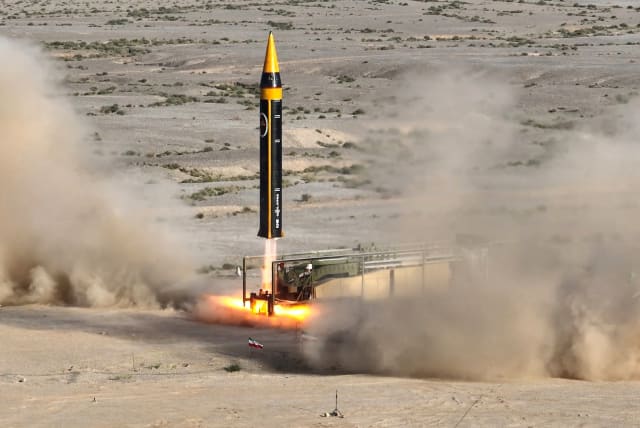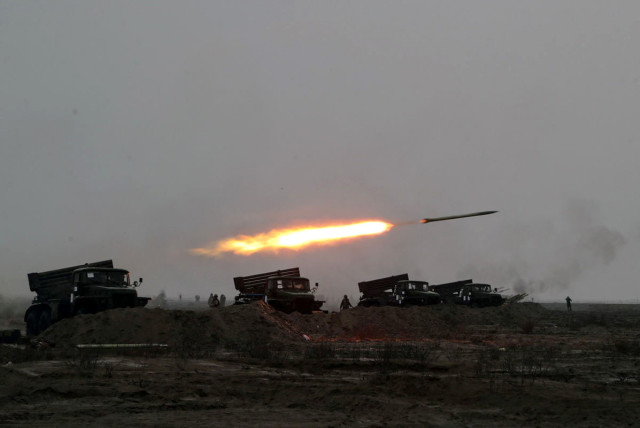Understanding Iran’s claims about testing a new ballistic missile - analysis

Iran announced the missile during state ceremonies marking the anniversary of a 1982 battle at Khorramshahr, part of their brutal war with Iraq.
Iran’s decision to test-fire a new long-range missile has raised eyebrows around the Middle East and in the West as it seeks to produce weapons that can carry out precision strikes and also evade radar while achieving high speeds during their flight to target.
One of the reasons Iran’s missiles are in the spotlight is the threat to Europe that these longer range missiles pose. Iran has supplied Russia with armed drones and its missile program is increasingly recognized as a growing threat outside the Middle East.
The projectile used by Iran in their latest test is a 4th generation Khorramshahr-class missile called Kheibar. Iran’s officials have implied that this is a reference to the destruction of “fortresses” in the early Islamic period that were inhabited by Jews, hinting at their overall intention to threaten Israel with these munitions.
The Khorramshahr class of missiles has been tested since 2017, and France and the US have both spoken out about the test firing. The US has called the development of these kinds of missiles a serious threat and says it opposes their further development.
UN Resolution 2231 curtails these developments but Iran nevertheless continues to conduct these tests while seeking the technology to increase its missiles range.
Iran announced the Kheibar during state ceremonies marking the anniversary of a 1982 battle at Khorramshahr, which occurred as part of their brutal war with Iraq.
Iran’s defense minister was present at the ceremony, and the head of the IRGC, Ismail Qaani, also spoke at an event at Dezful, north of Khorramshahr, to commemorate the war with Iraq. Iranian media and officials have discussed the history of the Islamic Revolutionary Guard Corps (IRGC) during the Iraq war, indicating how the missile test is wrapped up with Iran’s regime and the concept of its own history.
Iran believes it needs more missiles like this, built locally, to project its power around the region and not be forced to fight on its own territory as it did in the 1980s with Iraq.
“Iran’s development and proliferation of ballistic missiles poses a serious threat to regional and international security and remains a significant non-proliferation challenge,” US State Department spokesman Matthew Miller told reporters.
The spokesman for Iran’s foreign minister rejected criticism from the West about the missile. He also drew parallels with the 1980s and argued the West had backed the Saddam regime against Iran.
Iran’s Defense Ministry has said this is the most advanced version of a class of Iranian missiles, pointing to its use of an advanced engine system and navigation aid system with a large warhead.
“This missile also uses active phase guidance and control, middle phase guidance and control,” Iran’s Fars News reported. Iranian state media said the 4th generation missile is “precision-guided” with a 2,000 km. range and 1,500 kg. warhead.
The reports in Iranian state media also characterized this as a “stealth” missile that could evade radar and said that it is liquid-fueled and can be prepared for launch quickly.
According to the reports, it exits the earth’s atmosphere and travels up to Mach 16, re-entering the atmosphere at Mach 8 and boasts a unique guidance and control system that can adjust its trajectory as it travels to outer space and re-enters the earth’s atmosphere.
Iran boasted it was “invisible” to radar, although it was unclear if any of Iran’s claims can be independently verified.
Russian media heralded the success of this missile test, as the two countries work closely together. For Moscow, it is likely that any Iranian success with missiles and drones will help Russia distract the West from its own war in Ukraine.
The new missile test joins a long list of Iran’s claims about achievements in missile technology. Iran isn’t developing these missiles in secret, it likes to show them off. In February, Iran said it had developed a cruise missile with a range of 1,650 km. In November, they finished the development of a hypersonic ballistic missile, Revolutionary Guards’ aerospace commander Amir Ali Hajizadeh said.
Iran has continued to develop missiles rapidly in the wake of the Iran Deal in 2015, likely redirecting some resources from the nuclear program to the missile program in the years after 2015, before continuing to rapidly enrich uranium in the last several years as well.
In February 2019, Iran said it had built a new Hoveizeh cruise missile with a 1,200 km. range as part of celebrations for the 40th anniversary of the Iranian Revolution. At the time, it also displayed what it claimed was a Khorramshahr 2 medium-range ballistic missile with a range of 2,000 km. It also unveiled the Dezful medium-range missile, with a range of 1,000 km., an upgrade of a Zolfagher missile. These were solid-fueled missiles.
The country has continued apace with this development; working on a new space launch vehicle, and a new Shahab-3 missile, which in November 2019 it claimed it had equipped with a maneuverable re-entry vehicle. Later these variants were called Emad and Ghadr.
In drills in December 2021, Iran also tested the Sejjil missile. In March 2022 Iran also tested the Zuljanah space launch vehicle, and in September last year, Iran also showed off the Rezvan liquid-fueled missile which it said had a range of 1,400 kms.
Therefore, Iran’s new test of a missile joins a long lineage of testing and claims about new missiles. It frequently gives these missiles new names, even if they are very similar to previously known missiles, with some updates. Iran claims new abilities for these missiles, such as “pinpoint accuracy” and the ability to defeat air defenses.
Overall then, the new test of a missile should be seen in the context of Iran often claiming to test missiles with new capabilities during historic anniversaries and continuing to boast about them.
Considering that Iran has exported missile technology to the Houthis in Yemen and Hezbollah; as well as sending actual missiles to Syria, Lebanon and Iraq; the missile threats must be taken seriously. The overall threat to countries like Israel is that these missiles have large warheads and may be part of the larger Iranian drive for weaponizing its nuclear program.
In addition, Iran’s recent claims about the speed of the missiles and their ability to evade radar or electronic warfare are important, although it is impossible to determine if they are accurate. The overall picture is that Iran likes to make headlines with new missile tests.
While the country has an impressive and dangerous arsenal of missiles, one test of a new system doesn’t verify its abilities and lethality. Iran conducts these tests publicly, knowing it will get headlines and condemnations. If it wanted to develop missile capabilities in secret that could be a major threat, it might not be boasting of new capabilities publicly.
During a follow-up statement by Iran’s deputy defense minister for Logistics Mahdi Farhi, the official appeared to indicate this is a multi-stage missile, such that the warhead has its own guidance system and can reach high speeds and achieve greater accuracy. The official elaborated on claims that it is immune to electronic warfare, since it is not guided by satellites. He also elaborated on claims the warhead, that separates, has a low radar cross-section and that the missile can change direction during later stages of flight.
He claimed the liquid propulsion that has been used has also been designed to increase the launch speed and overall speed of the missile. He added that it takes about a quarter of an hour to reach its target and that it also takes about 15 minutes to prepare for launch because liquid fueled missiles take longer to prepare.
Farhi says the missile should be classified as a conventional weapon, apparently a reference to evading new sanctions on the test.
The Iranian official next outlined Iran’s next steps which include serial production and also an economy of scale to produce new missiles and products as well as an attempt to create flexibility in the warheads, to install optical seekers and radar to hit “moving targets.” Another goal is to produce missiles that can evade radar and also increase their speed.
“The Deputy Minister of Defense emphasized,” according to Fars News in Iran that “our optimized Simorgh launcher will be launched soon, and the Zuljanah satellite carrier [SLV] will also be launched in the next two to three months. Soroush and Sarir satellite receivers will also be launched in the coming years. During a two-year planning, we will have the first launch from the Chabahar base, and in the near future, we will have mass deliveries of solid fuel strategic missiles to the IRGC Aerospace Force.”
Jerusalem Post Store
`; document.getElementById("linkPremium").innerHTML = cont; var divWithLink = document.getElementById("premium-link"); if (divWithLink !== null && divWithLink !== 'undefined') { divWithLink.style.border = "solid 1px #cb0f3e"; divWithLink.style.textAlign = "center"; divWithLink.style.marginBottom = "15px"; divWithLink.style.marginTop = "15px"; divWithLink.style.width = "100%"; divWithLink.style.backgroundColor = "#122952"; divWithLink.style.color = "#ffffff"; divWithLink.style.lineHeight = "1.5"; } } (function (v, i) { });


